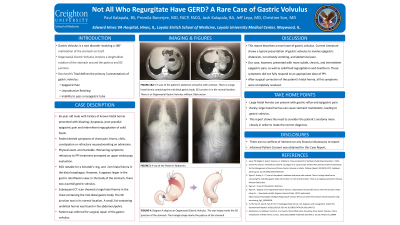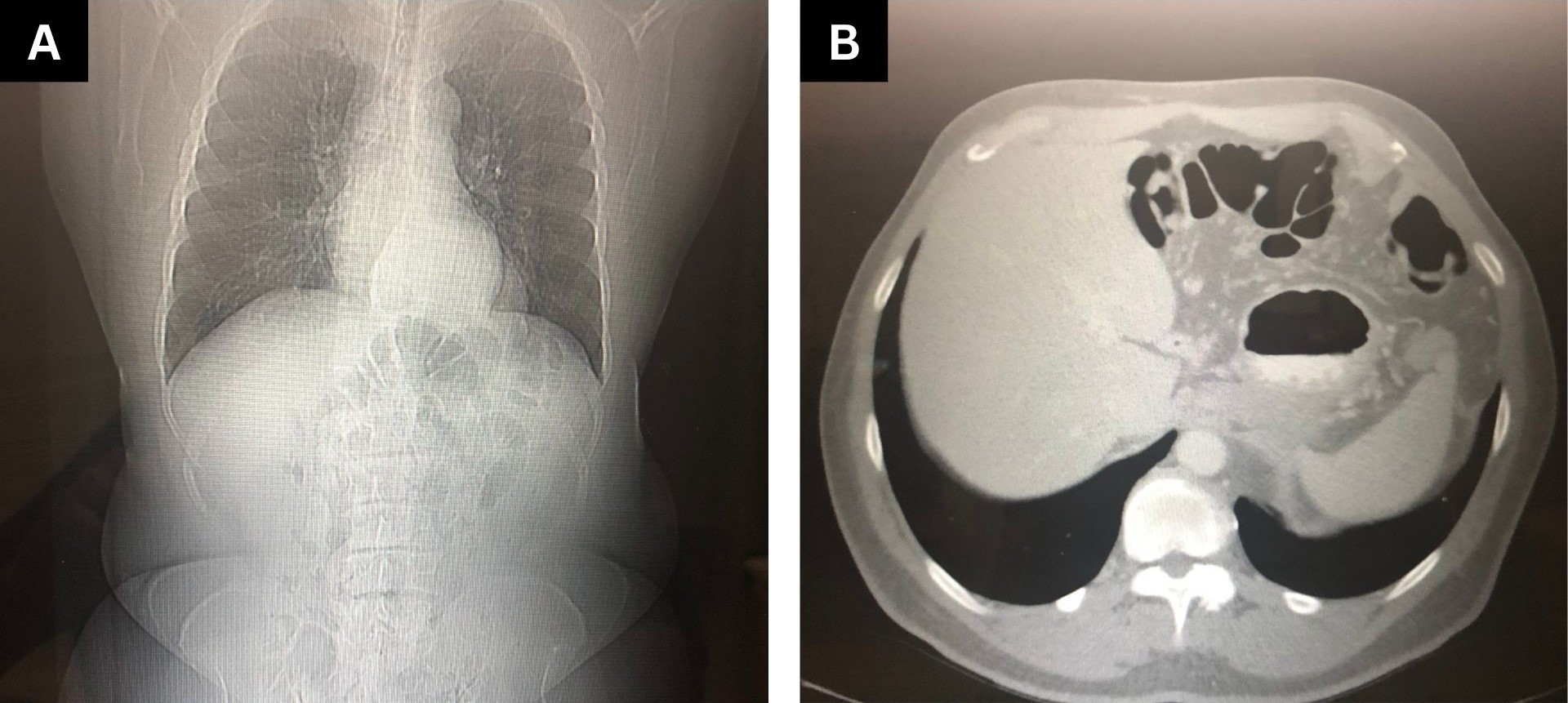Monday Poster Session
Category: Stomach
P3347 - Not All Who Regurgitate Have GERD? A Rare Case of Gastric Volvulus
Monday, October 28, 2024
10:30 AM - 4:00 PM ET
Location: Exhibit Hall E

Has Audio

Paul Kalapala, BS
Edward Hines Jr. Veterans Affairs Hospital
Hines, IL
Presenting Author(s)
Paul Kalapala, BS1, Promila Banerjee, MD, FACG2, Joshua Kalapala, BA3, Jeff Leya, MD4, Christine Son, MD5
1Edward Hines Jr. Veterans Affairs Hospital, Hines, IL; 2Edward Hines Jr. Veterans Affairs Hospital, Loyola University Chicago Stritch School of Medicine, Maywood, IL; 3Loyola University Chicago Stritch School of Medicine, Hines, IL; 4Edward Hines Jr. Veterans Affairs Hospital, Maywood, IL; 5Loyola University Medical Center, Maywood, IL
Introduction: Gastric volvulus is a rare condition that typically involves 180o malrotation of the stomach. Common symptoms are non-bloody vomiting, epigastric distension and regurgitation. We present a case of gastric volvulus with refractory GERD-like symptoms.
Case Description/Methods: A 65-year-old male with a history of known hiatal hernia presented with bloating, dyspepsia, post-prandial epigastric pain, and intermittent regurgitation of solid foods. He had no chest pain, fevers, constipation, or nausea and vomiting. Physical examination was benign. Worsening symptoms refractory to PPI treatment prompted an upper endoscopy evaluation.
There was a significant looping preventing scope advancement to the duodenum even with the small, pediatric colonoscope. The patient was found to have a Schatzki’s ring in the distal esophagus and a partial gastric volvulus in the stomach body.
The CT scan following the EGD showed a 2cm hiatal hernia in the distal esophagus, containing the mid-distal gastric body. The GE junction was in the normal location with no evidence of obstruction. The patient was diagnosed with organoaxial gastric volvulus without obstruction. Patient is currently asymptomatic off of PPI after a successful robotic hiatal hernia repair.
Discussion: From our limited data, one report states that GERD is not often associated with gastric volvulus.1 However, patient’s only presenting symptoms were that of atypical GERD: intermittent regurgitation of solid foods and post-prandial epigastric pain. The lack of response to standard PPI treatment prompted further consideration of the patient’s variant anatomy. Hiatal hernias of large size can cause gastric reflux and epigastric pain.2 Rarely, they cause stomach malrotation, producing a gastric volvulus.3
This case report highlights the importance of detailed history and prompt endoscopic evaluation in the absence of therapeutic response to standard PPI therapy. GERD symptoms can be secondary to altered anatomy that may need surgical correction.
1. Sergio Szachnowicz, et al., Organoaxial Gastric Volvulus Determining Gastroesophageal Reflux Disease: A Forgotten Relation Cause, September 24, 2022, p.141.
2. Yu HX, et al., Esophageal hiatal hernia: risk, diagnosis and management, February 22, 2018, pp.319-329.
3. Sanekommu H, et al., Gastric Outlet Obstruction Caused by Acute Gastric Volvulus: A Rare Complication of Hiatal Hernia, May 5, 2023.

Disclosures:
Paul Kalapala, BS1, Promila Banerjee, MD, FACG2, Joshua Kalapala, BA3, Jeff Leya, MD4, Christine Son, MD5. P3347 - Not All Who Regurgitate Have GERD? A Rare Case of Gastric Volvulus, ACG 2024 Annual Scientific Meeting Abstracts. Philadelphia, PA: American College of Gastroenterology.
1Edward Hines Jr. Veterans Affairs Hospital, Hines, IL; 2Edward Hines Jr. Veterans Affairs Hospital, Loyola University Chicago Stritch School of Medicine, Maywood, IL; 3Loyola University Chicago Stritch School of Medicine, Hines, IL; 4Edward Hines Jr. Veterans Affairs Hospital, Maywood, IL; 5Loyola University Medical Center, Maywood, IL
Introduction: Gastric volvulus is a rare condition that typically involves 180o malrotation of the stomach. Common symptoms are non-bloody vomiting, epigastric distension and regurgitation. We present a case of gastric volvulus with refractory GERD-like symptoms.
Case Description/Methods: A 65-year-old male with a history of known hiatal hernia presented with bloating, dyspepsia, post-prandial epigastric pain, and intermittent regurgitation of solid foods. He had no chest pain, fevers, constipation, or nausea and vomiting. Physical examination was benign. Worsening symptoms refractory to PPI treatment prompted an upper endoscopy evaluation.
There was a significant looping preventing scope advancement to the duodenum even with the small, pediatric colonoscope. The patient was found to have a Schatzki’s ring in the distal esophagus and a partial gastric volvulus in the stomach body.
The CT scan following the EGD showed a 2cm hiatal hernia in the distal esophagus, containing the mid-distal gastric body. The GE junction was in the normal location with no evidence of obstruction. The patient was diagnosed with organoaxial gastric volvulus without obstruction. Patient is currently asymptomatic off of PPI after a successful robotic hiatal hernia repair.
Discussion: From our limited data, one report states that GERD is not often associated with gastric volvulus.1 However, patient’s only presenting symptoms were that of atypical GERD: intermittent regurgitation of solid foods and post-prandial epigastric pain. The lack of response to standard PPI treatment prompted further consideration of the patient’s variant anatomy. Hiatal hernias of large size can cause gastric reflux and epigastric pain.2 Rarely, they cause stomach malrotation, producing a gastric volvulus.3
This case report highlights the importance of detailed history and prompt endoscopic evaluation in the absence of therapeutic response to standard PPI therapy. GERD symptoms can be secondary to altered anatomy that may need surgical correction.
1. Sergio Szachnowicz, et al., Organoaxial Gastric Volvulus Determining Gastroesophageal Reflux Disease: A Forgotten Relation Cause, September 24, 2022, p.141.
2. Yu HX, et al., Esophageal hiatal hernia: risk, diagnosis and management, February 22, 2018, pp.319-329.
3. Sanekommu H, et al., Gastric Outlet Obstruction Caused by Acute Gastric Volvulus: A Rare Complication of Hiatal Hernia, May 5, 2023.

Figure: A) Gaseous distension of loops of bowel in the left upper abdomen seen on abdominal x-ray.
B) Large hiatal hernia containing mid-distal gastric body seen on CT imaging. Gastroesophageal junction is in normal location with no obstruction.
B) Large hiatal hernia containing mid-distal gastric body seen on CT imaging. Gastroesophageal junction is in normal location with no obstruction.
Disclosures:
Paul Kalapala indicated no relevant financial relationships.
Promila Banerjee indicated no relevant financial relationships.
Joshua Kalapala indicated no relevant financial relationships.
Jeff Leya indicated no relevant financial relationships.
Christine Son indicated no relevant financial relationships.
Paul Kalapala, BS1, Promila Banerjee, MD, FACG2, Joshua Kalapala, BA3, Jeff Leya, MD4, Christine Son, MD5. P3347 - Not All Who Regurgitate Have GERD? A Rare Case of Gastric Volvulus, ACG 2024 Annual Scientific Meeting Abstracts. Philadelphia, PA: American College of Gastroenterology.

